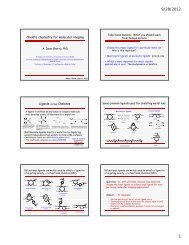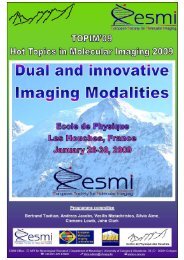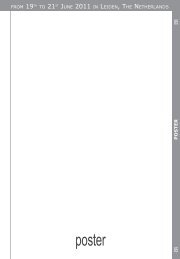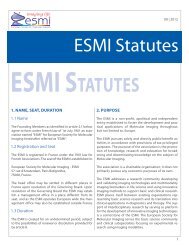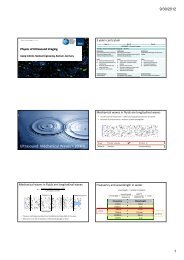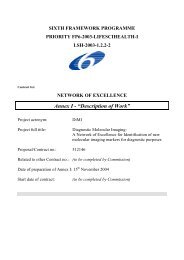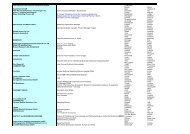5th EuropEan MolEcular IMagIng MEEtIng - ESMI
5th EuropEan MolEcular IMagIng MEEtIng - ESMI
5th EuropEan MolEcular IMagIng MEEtIng - ESMI
You also want an ePaper? Increase the reach of your titles
YUMPU automatically turns print PDFs into web optimized ePapers that Google loves.
<strong>5th</strong> <strong>EuropEan</strong> <strong>MolEcular</strong> <strong>IMagIng</strong> <strong>MEEtIng</strong> – EMIM2010<br />
Detection of inflammatory diseases by NIRF imaging with specific probes targeting<br />
leukotriene receptor CysLT 1 R<br />
Busch C. (1) , Passon M. (1) , Lehmann F. (2) , Socher I. (1) , Kaiser W.A. (1) , Hilger I. (1) .<br />
(1) University Hospital Jena, IDIR, Jena, Germany<br />
(2) DYOMICS GmbH, Jena, Germany<br />
Corinna.Busch@med.uni-jena.de<br />
Introduction: Leukotriene synthesis occurs early<br />
in inflammatory processes and plays a major role<br />
for the recruitment of leukocytes to the inflamed<br />
region (1). A key representative of these eicosanoids,<br />
leukotriene D4 (LTD4), shows high affinity<br />
to G-protein coupled cysteinyl leukotriene<br />
receptor 1 (CysLT 1 R). Detection of CysLT 1 R by<br />
molecular imaging (2) with near-infrared (NIR)<br />
fluorophores could be a suitable diagnostic tool<br />
for early identification of inflammatory processes.<br />
Aim of this study was the design and characterization<br />
of NIRF-based contrast agents specifically<br />
targeting CysLT 1 R in order to develop future diagnostic<br />
tools for inflammatory diseases, particularly<br />
in early stages.<br />
Methods: Polyclonal rabbit CysLT 1 R antibody<br />
(CysLT 1 R*DY-734) or polyclonal rabbit-IgG<br />
(IgG*DY-734) as well as the corresponding Fab<br />
fragments (Fab-CysLT 1 R*DY-734, Fab-IgG*DY-<br />
734) were bound to activated NHS ester of NIRfluorophore<br />
DY-734 (Dyomics, Jena, Germany).<br />
Probes were characterized by determining dye/protein<br />
ratios. After verification of CysLT 1 R expression<br />
(PCR, flow cytometry) in HL-60 cells, binding<br />
of the synthesized probes in vitro was assessed by<br />
flow cytometry. In vivo, an ear edema was induced<br />
in mice (3), and NIR fluorescence was measured<br />
with whole body imaging system Maestro2.2 after<br />
i.v.-probe administration. Ex vivo biodistribution<br />
studies were performed.<br />
Results: Flow cytometry proved binding of CysLT 1 R*DY-<br />
734 and IgG*DY-734 to CysLT 1 R-expressing HL-60. In<br />
vivo, all probes revealed stronger binding to the edematous<br />
than to the corresponding healthy region. 6<br />
h post injection, specific CysLT 1 R*DY-734 and Fab-<br />
CysLT 1 R*DY-734 demonstrated 1.9 and 1.2 fold higher<br />
binding than IgG*DY-734 and Fab-IgG*DY-734,<br />
respectively. Investigation of isolated organs revealed<br />
that full length IgG´s are eliminated via liver, while<br />
Fab fragments additionally accumulated in kidney.<br />
Conclusions: A novel NIRF-based probe specifically targeting<br />
Leukotriene D 4 receptor CysLT 1 R allows detection<br />
of inflammatory processes in ear edema-induced<br />
mice in early stages.<br />
Acknowledgement: The present investigations were<br />
supported by the “Deutsche Forschungsgemeinschaft”<br />
within the DFG program Hi 689/6-1.<br />
References:<br />
1. Hui Y, Funk C. Cysteinyl leukotriene receptors. Biochem.<br />
Pharmacol. 2002;64:1549-57.<br />
2. Weissleder R, Mahmood U. Molecular Imaging.<br />
Radiology 2001;219:316-33.<br />
3. Kurnatowska I, Pawlikowski M. Anti-inflammatory<br />
effects of somatostatin analogs on zymosaninduced<br />
earlobe inflammation in mice:<br />
comparison with dexamethasone and ketoprofen.<br />
Neuroimmunomodulation 2001;9:119-24.<br />
<strong>EuropEan</strong> SocIEty for <strong>MolEcular</strong> <strong>IMagIng</strong> – <strong>ESMI</strong><br />
P-086<br />
poStEr<br />
INFECTION and INFLAMMATION



